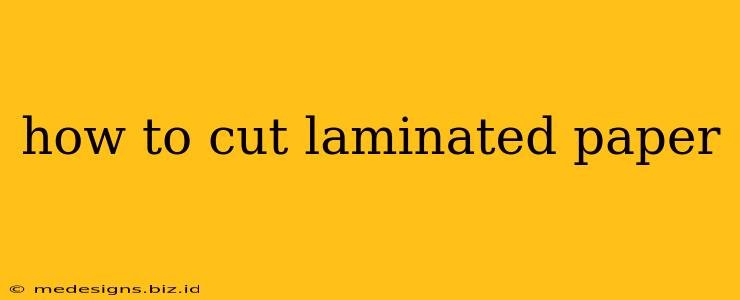Laminated paper, with its protective layer, offers durability and a professional finish to various projects. However, cutting it cleanly can be tricky. This guide provides you with the best methods and tools to achieve precise cuts every time, whether you're working on a small craft project or a large-scale presentation.
Choosing the Right Tools for the Job
The key to successfully cutting laminated paper lies in selecting the appropriate tools. Using the wrong tool can lead to jagged edges, tearing, and frustration. Here's a breakdown of the best options:
1. Rotary Cutter: The Champion of Clean Cuts
For achieving consistently clean, straight lines, a rotary cutter is your best friend. Its sharp, rotating blade slices through the laminate effortlessly, minimizing the chance of tearing. Make sure you use a self-healing cutting mat to protect your work surface and extend the life of your blade. A rotary cutter is ideal for:
- Straight lines: Perfect for trimming photos, creating borders, or cutting large sheets of laminated paper.
- Precise cuts: Offers greater accuracy than scissors, especially for intricate designs.
- Speed and efficiency: Significantly faster than using scissors for larger projects.
2. Paper Trimmer/Guillotine: Accuracy and Efficiency for Bulk Cutting
If you frequently need to cut large quantities of laminated paper to precise sizes, a paper trimmer or guillotine is a worthwhile investment. These tools offer a clean, straight cut with minimal effort, making them perfect for tasks like:
- Batch cutting: Quickly and efficiently cut multiple sheets of laminated paper to the same size.
- Perfect alignment: Ensures all your cuts are perfectly straight and uniform.
- Different sizes: Many models offer adjustable cutting guides to accommodate various sizes.
3. Scissors: The Go-To for Smaller, More Intricate Cuts
While not the ideal choice for large sheets or straight lines, scissors can be useful for smaller, more detailed cuts. For laminated paper, opt for sharp, heavy-duty scissors designed for cutting thicker materials. Scissors are best suited for:
- Curved lines and shapes: Ideal for cutting out complex shapes or designs.
- Small projects: Suitable for smaller cutting tasks where a rotary cutter or paper trimmer would be overkill.
- Detail work: Allows for greater control and precision in cutting intricate details.
Techniques for a Perfect Cut
Regardless of the tool you choose, mastering the right cutting technique will significantly improve your results. Here are some tips for clean cuts:
- Sharp blades are essential: Dull blades will tear and fray the laminate, resulting in uneven cuts. Regularly replace or sharpen your blades.
- Use a cutting mat: Protect your work surface and extend the life of your blade by using a self-healing cutting mat.
- Score the laminate first (optional): For thicker laminates, scoring the line with a bone folder or similar tool before cutting can help prevent tearing.
- Apply even pressure: Avoid applying too much pressure, as this can cause the laminate to buckle or tear.
- Practice makes perfect: Take your time and practice your cutting technique.
Troubleshooting Common Cutting Problems
- Jagged edges: This indicates a dull blade or uneven pressure. Replace the blade or use a sharper tool.
- Tearing: The laminate might be too thick or the blade isn't sharp enough. Try scoring the laminate first or use a more powerful tool.
- Inconsistent cuts: Ensure the cutting surface is stable and you are applying even pressure.
By following these tips and choosing the right tools, you'll be able to cut laminated paper with precision and ease, transforming your projects from ordinary to extraordinary. Remember, the right technique and sharp tools are your allies in achieving those perfect, clean cuts.
